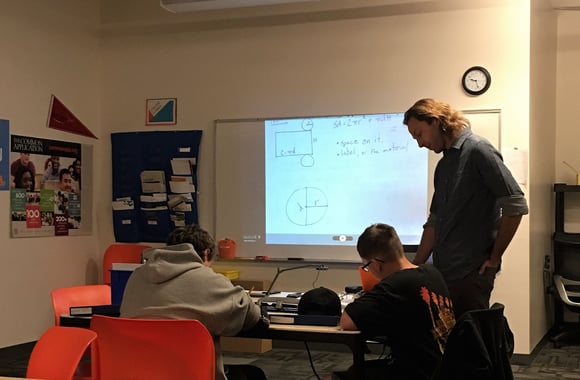4 Superior Reasons Small Class Size in Charter Schools are Vital for Student Success

Providing an education for your children is one of the most awesome responsibilities parents have. The quality of your children’s education is the gateway to future opportunities and determines, in part, their success in college and beyond. Finding the type of school for your children is important. Charter schools are an option that has gained popularity as parents discover their unique offerings. From customized instruction to personal class size, there is something for everyone. Small class size is big feature of charter schools that make them attractive to parents and students. Here are 4 ways a small school helps students.
1. Encourages a much-needed positive student-teacher relationship
We all have memory of at least one teacher that has made an impact on our lives, whether good or bad. And just as family and friends are vital to a student's development, so are teachers. Teachers are, by nature of their position, role models. Therefore, the teacher’s relationship with the student cannot be underestimated. Additionally, when you think of the vast amount of time teachers spend with their students, it is no wonder that their influence is far reaching! According to an article from the NYU Psychology Department, students who form a healthy positive relationship with their teachers benefit in the following ways when they:
- Feel “safe and secure in their learning environments.”
- Gain relevant academic skills through the scaffolding process.
- Strengthen emotional intelligence quotient through the scaffolding process.
It’s obvious that a student’s positive relationship with his or her teacher profoundly influences how well he or she does in the classroom, but just how are these relationships realized? One important element is the classroom environment. The NYU Psychology Department states 3 key factors play a part in the atmosphere conducive for learning: “Closeness, warmth, and positivity.” Why are these 3 factors so important? Sara Rimm-Kaufman, PhD, and Lia Sandilos, PhD, University of Virginia explain that students who experience warm reception from their teacher during the learning process in addition to positive and praising responses, develop trust for their teacher. In addition, positivity encourages greater student engagement. It serves as a reward. Then, as the student trusts his or her teacher and diligently engages, success is inevitable. It all begins with a vibrant relationship between the student and teacher.
But, many parents assume that those relationship automatically happen when a student begins his journey through school. The truth is not all relationships can be formed when circumstances do not align. And many students do not get to benefit from a close and nurturing teacher relationship. Besides fomenting a positive and nurturing educational environment it is fundamentally important for the students to feel that they have access to their role model.
In charter schools small classrooms are the stanbdard. Teachers are not overwhelmed with too many students, thus allowing them to fully devote their time and energy to the few students in their charge and helping to create an atmosphere conducive to enhanced student-teacher relationships. Charter schools are uniquely set up to allow student-teacher relationships to blossom naturally.
2. Allows introverted, shy, or anxious students to be heard
According to the Journal of School Psychology, introverted, shy, or withdrawn students performed the worst on literacy and mathematics tests. It is certainly not because they are any less capable then the student sitting beside them. Usually students who are shy refrain from asking questions when they do not understand some of the material, or even to ask for additional support..
In addition, shy students rarely participate in classroom discussions. When the teacher and students are engaging in critical thinking skills or “what would happen if” scenarios, the shy student hangs back and thus misses out on an opportunity for academic and social growth. Shy students may very well have an idea or the answer, but fear or anxiety holds them back. The unfortunate consequence is that shy students develop knowledge gaps that are difficult to overcome later.
A small school provides a safe haven for the shy or anxious student. With a reduced number of students in the classroom, these students often overcome anxiety and find the courage to ask questions and participate. The learning environment is greatly enhanced in a small school setting.
3. Fosters close-knit relationships among classmates
Small schools are one in which just about everyone knows everyone. The number of total students makes that possible. At the very least students know everyone in their classroom and probably a few more. The small school fosters a sense of community among the students. Students tend to be more supportive of one another when the classroom size is limited to a small handful. Close-knit relationships found among smaller schools are commonplace and in turn enhances the learning environment. Behaviorists believe positive friendships in an academic setting improve students’ performance.
4. Reduces bullying
Bullying has become a national problem and a tragedy for many students. Students who are bullied often fear reporting the bullying done by their peers. Left unchecked, bullying hinders the learning process, leaves lasting scars, leads to depression, and has even resulted in suicides. No student should ever have to endure the pain of being bullied. According to government statistics, about “49% of children in grades 4-12 reported being bullied by other students at school at least once during the past month.” Bullying may be so rampant at large public schools because the bullies feel hidden from sight with the vast number of students. Staff members are in the minority by far and rarely see the perpetrator in the act, so it is easy for the bully to get away with his or her actions. Large schools also are more likely to have difficulty enforcing bullying like a smaller school will. Research by Niche discovered that public schools fell far behind private schools in their anti-bullying policies. There was no data on public versus charter school in regards to bullying. However, charter schools are small like private schools. So, it follows that charter schools have less bullying.
At Method Schools, we are committed to providing students with a superior education. Connect with us for more information!


-1.svg)
-1.svg)
.svg)

.svg)














